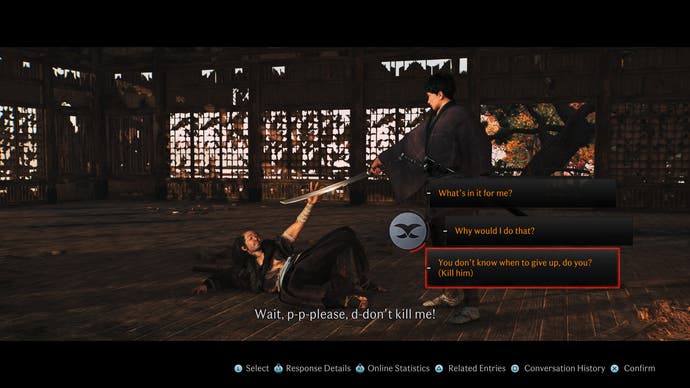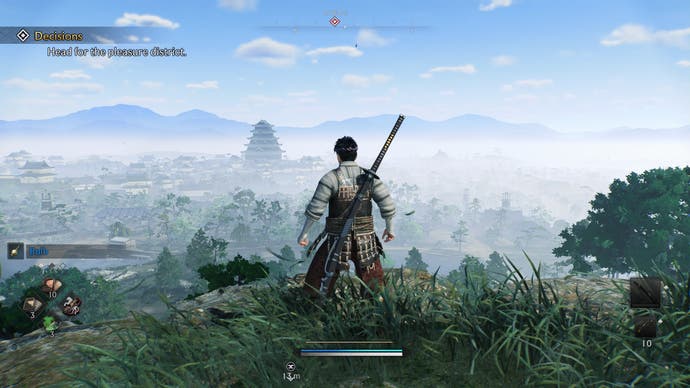Games set in the Bakumatsu period must feel like buses. You wait almost a decadence for one to be made, and then two come along in successive years. After last year's Like A Dragon: Ishin took us to late 19th century Japan, Rise of the Ronin feels like a trip into familiar territory. It's perhaps even more familiar, as this is an open-world game that's quite happy to borrow from the Ubisoft playbook of maps overstuffed with icons, as well as other modern trends. Wing gliding? Sure! Dogs and cats to pet? Why not! And yet it is new territory all the same for Team Ninja. Having spent the past few years as a worthy rival to FromSoftware, with its own take on the Soulslike, this marks a departure: it's more grounded than you might expect, all while evolving the Ki-based mechanics first employed in Nioh for a wider audience .
As another third-party PS5 exclusive to fill out the lack of Sony's own first-party efforts, it certainly looks the part. That first shot as your nameless protagonist arrives in Yokohama gazing over its rolling fields and the nearby sea looks simply sumptuous. Move in and it's hard not to notice the light reflecting off long grass or water, or the detailed architecture – a mixture of both Japanese and Western designs. Riding on horseback with Mt. Fuji in the background it's clear: Cor! We've come a long way since Nioh's identikit caverns and ransacked villages.
This beauty is balanced with brutality once you encounter unruly enemies roaming the city's outskirts or deserted settlements. The fights that dream usually result in a finishing blow that sees blood gushing with the severity of heads or limbs. Combat has been simplified to the extent that there is just one attack button rather than light and heavy, while another attack is actually a counterspark, the game's form of parrying, which you'll need for deflecting combos to wear down your opponent's Ki (stamina ) before following up with a critical attack. What I do appreciate is that even if you opt for the easier difficulty, the game doesn't just turn into a hack-and-slasher. You still have to respect this mechanic.
Rise of the Ronin – Pre-Order Trailer | PS5 Games
It's not all just about mastering combat technique though. For all the displays of gore the game delights in with direct confrontation, you can opt for stealthier methods, enough to take down grunts in one go, while severely weakening the 'formidable' enemies. You can also choose not to shed blood at all by fighting unarmed, even though that puts you at a disadvantage in attack power. Animal lovers will be pleased that there's a skill that replaces silent takedowns with taming hostile creatures who then fight alongside you. So yes, you can pet the dog, but it's not just there to pander to the good boy crowd. Whatever methods you decide, it's satisfying restoring order, which sees abandoned roads or villages once again teeming with citizens going about their day; a simple luxury at a time when the country is facing socio-political instability.
Freed from solely action-oriented missions, the open-world structure allows Team Ninja to do more than just kill or be killed, even if its attempts at dialogue-based narrative choices don't go as deep as combat. There are ways to gain skill points for leveling up outside of combat, such as activating the many banners that are used for fast-traveling. Player progression is also more palatable, as you're not just making seemingly arbitrary stats go up. Instead, you have skills you can unlock or upgrade that are tied to one of four attributes – strength, dexterity, charm, and intellect – with the latter's associated stats increasing for every two skills you unlock within those categories.


Despite this streamlining, Ronin still falls victim to some messy UI and fiddly controls. Special moves called martial skills don't require any complex inputs, but you'll have to memorize these skills based on the combat style they're associated with. The latter you also switch between by holding R1 and then moving the right stick in a given direction. There are multiple combat styles you can learn and remap, and you're encouraged to switch by parsing a tiny blue or orange icon to see if it's effective or ineffective against the enemy you're locked on to. It's a lot to wrap your head around, in other words. That's before getting to the fussy menus, which took me a good while just to figure out how to view all my items, and not just the consumable ones.
Japan's path to modernization has often been referred to as a bloodless revolution. Ronin suggests that this was far from the case, even if the game subverts history outlandishly, such as giving you the chance to assassinate Commodore Perry, the man responsible for opening up Japan after centuries of isolationism. But revolution is just as much about ideas and allegiances, and so bonds play a key role here. Initially, this is more abstract and gamey stuff, as the more you tick off a list of tasks and collectibles in any specific area, the higher your 'bond' becomes with that area. But it's also about the relationships formed with the many real, albeit embellished, historical figures you encounter, ranging from vendors to combat allies.


It's quite the cast too, including major players like Ryoma Sakamoto – compared to the one resembling Kazuma Kiryu, he's depicted as a more laid-back sort who enjoys hanging out in the pleasure district with geishas, including one who adopts Western dress. Fortunately, the game's depiction of women is varied too, with the inclusion of real female warriors from that period. These all provide a human face to the clashing ideals brewing in Japan, as you're asked to ally yourself with pro-shogunate or anti-shogunate forces, a concept I admit still has me scratching my head as to what each side represents. Fortunately, you're allowed to be fairly fickle about up to a point. It's easier to empathize with an individual character's needs and the rewards you'll get for improving your bond with them rather than considering their political leanings. Even so, some of your decisions will result in you clashing with some bond characters.
For the most part, Ronin depicts both sides of the conflict as simply having different visions for the country's future, but without any further interrogation or criticism. It might seem like a given to ally with the anti-shogunate forces, but they're hardly anti-colonialists when, in modernizing Japan, they also adopted the West's imperialist ideas, including the occupation and annexation of Korea. (Conveniently this happens in a period after the game's setting and so is never touched upon.) Yet while expulsionist feelings run high, this is as much a game about mixing and matching cultures. After all, your player-created character needs not to be Japanese in appearance, while your weapons of choice can also include rifles and flamethrowers alongside katanas and odachi. Even with one preposterous depiction of one diplomatic figure who fights you while wearing jet boots, the Western characters are more than xenophobic caricatures.
The bonds that most stick with you are the ones who can also accompany you in story missions. These are reminiscent of the linear missions of Nioh, albeit shorter and still set within the open world, but with limits in terms of how far you can wander. Wo Long also let you bring in ally characters, although it was missing a trick. Why only have Ryoma fight with you when you can also take control of him? And so you can toggle control between characters here, allowing you to get a taste for different combat styles that you'll also get to learn in due time. Better still, these characters act as a second chance. Meet your end and control automatically switches to another ally, who can also revive you if you have medicine to spare.


It's such a good time with AI-controlled pals that you're unlikely to seek help from other players. (While playing during review period means there's a lower player pool, co-op is still woefully limited to just story missions instead of open world exploration and raids.) Yet there's a nice touch where you'll occasionally see other players' AI-controlled Ronin wandering around the map to give a sense of an asynchronous online world. You might even come across one held captive during a raid on an enemy camp, who can then act as a temporary ally.
If there's a downside to a more grounded, less fantastical depiction, it's that the strictly human bosses lack the feeling of an event. More often than not, a mission ends with you fighting a large lad wielding a large weapon, and that's about the size of it. There'll also be characters you face multiple times who never really evolve with each confrontation. Even when factoring in the absence of the supernatural, there's no one as memorable or larger-than-life as, say, Wo Long's Lu Bu.
As a Sony-published release, Ronin isn't quite Team Ninja's Elden Ring, even if it does evolve its Nioh-like formula, with the help of existing open world formulae. Still, while it's been great to witness the renaissance of Japanese games these past few years, there's something special about seeing a Japanese developer stepping up to reclaim the AAA open world samurai game for itself – especially one that cares more about being a video game than to Kurosawa film.
Review code for Rise of the Ronin was supplied by Team Ninja.
#Rise #Ronin #review #samurai #action #that39s #grounded #approachable